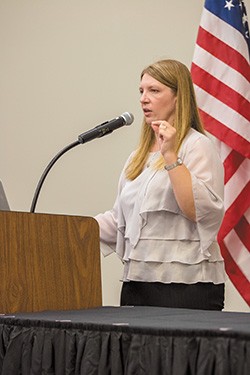NWA Wage Growth, GDP Rise Is On a Par With Bigger Metros
by October 12, 2015 12:00 am 141 views

Northwest Arkansas often performed as well as or better than its peers within a new, more competitive benchmark group, according to the fifth-annual State of the NWA Region Report.
Before this year, the Northwest Arkansas Council, which commissions the yearly report, measured Northwest Arkansas against the metropolitan areas surrounding Omaha, Nebraska, Tulsa, Oklahoma, Huntsville, Alabama, Knoxville, Tennessee, and Kansas City, Missouri.
However, the council team decided, upon starting its new, three-year strategic plan in January, that the region should be held to a higher standard.
“We were punching above our weight, and we thought, maybe we need to look at a new weight class,” said Mike Harvey, chief operating officer of the council.
This year’s State of the NWA Region Report looked at the larger metro areas of Austin, Texas, Des Moines, Iowa, Madison, Wisconsin, and the Raleigh-Durham region of North Carolina, known as the Research Triangle.
The Center for Business and Economic Research at the University of Arkansas’ Sam M. Walton College of Business conducted the study, which was released Oct. 2 at a luncheon in Lowell.
Kathy Deck, director of the center, noted her initial skepticism with the new benchmarks.
“Northwest Arkansas, although we live big, we’re not the same size as Austin; we’re not the same size as the Research Triangle,” Deck said, during the luncheon.
However, the NWA is holding its own against these regions in some important metrics, she said.
For example, the region is doing well in two areas that make it more attractive to new residents: homeownership cost and commute time.
Homeownership costs in NWA were the lowest among all the peer regions, accounting for 16.3 percent of household income in 2014, according to the report.
With 75 percent of local workers spending fewer than 30 minutes in commutes to work, NWA had the second-shortest average commute, behind Des Moines.
In addition, the metro GDP grew 4.4 percent in 2014, higher than each of the peer metro areas, except for Austin, according to the report.
While some of the region’s other numbers do not look as good, the rate at which they are improving does, Deck said.
Per capita income and wages in NWA are lower than its peer metros, but its wages growth rate from 2010 to 2014 was significantly higher.
The 2014 unemployment rate, at 4.6, was the highest among the peer metros, according to the report.
However, it was better than the state and the nation overall, and employment in the region grew at an average annual rate of 2.9 percent between 2010 and 2014, slower than Austin and the Research Triangle, but faster than the other metros.
The latest unemployment rate for NWA, posted by CBER in August 2015, is 3.6.
The poverty rate was the second highest in the peer group, at 16.2 in 2014, but it showed a 0.6-percent decrease from the previous year.
Establishment growth and the percentage of adults with college education are stats that have not shown much improvement in recent years.
Between 2010 and 2014, establishments in NWA increased at an average rate of 0.9 percent per year, reaching a total of 11,998.
“Establishment growth is the thing we need to keep our eye on most closely,” Deck said, “while the area sees plenty of new businesses open, others are closing at the same time.”
